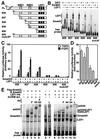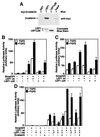Association of Smads with lymphoid enhancer binding factor 1/T cell-specific factor mediates cooperative signaling by the transforming growth factor-beta and wnt pathways
- PMID: 10890911
- PMCID: PMC26952
- DOI: 10.1073/pnas.150152697
Association of Smads with lymphoid enhancer binding factor 1/T cell-specific factor mediates cooperative signaling by the transforming growth factor-beta and wnt pathways
Abstract
The transforming growth factor-beta (TGFbeta) and Wnt/wingless pathways play pivotal roles in tissue specification during development. Activation of Smads, the effectors of TGFbeta superfamily signals, results in Smad translocation from the cytoplasm into the nucleus where they act as transcriptional comodulators to regulate target gene expression. Wnt/wingless signals are mediated by the DNA-binding HMG box transcription factors lymphoid enhancer binding factor 1/T cell-specific factor (LEF1/TCF) and their coactivator beta-catenin. Herein, we show that Smad3 physically interacts with the HMG box domain of LEF1 and that TGFbeta and Wnt pathways synergize to activate transcription of the Xenopus homeobox gene twin (Xtwn). Disruption of specific Smad and LEF1/TCF DNA-binding sites in the promoter abrogates synergistic activation of the promoter. Consistent with this observation, introduction of Smad sites into a TGFbeta-insensitive LEF1/TCF target gene confers cooperative TGFbeta and Wnt responsiveness to the promoter. Furthermore, we demonstrate that TGFbeta-dependent activation of LEF1/TCF target genes can occur in the absence of beta-catenin binding to LEF1/TCF and requires both Smad and LEF1/TCF DNA-binding sites in the Xtwn promoter. Thus, our results show that TGFbeta and Wnt signaling pathways can independently or cooperatively regulate LEF1/TCF target genes and suggest a model for how these pathways can synergistically activate target genes.
Figures







Similar articles
-
The murine gastrin promoter is synergistically activated by transforming growth factor-beta/Smad and Wnt signaling pathways.J Biol Chem. 2004 Oct 8;279(41):42492-502. doi: 10.1074/jbc.M404025200. Epub 2004 Jul 28. J Biol Chem. 2004. PMID: 15292219
-
Smad4 and beta-catenin co-activators functionally interact with lymphoid-enhancing factor to regulate graded expression of Msx2.J Biol Chem. 2003 Dec 5;278(49):48805-14. doi: 10.1074/jbc.M305472200. Epub 2003 Oct 9. J Biol Chem. 2003. PMID: 14551209
-
Transcriptional regulation by Smads: crosstalk between the TGF-beta and Wnt pathways.J Bone Joint Surg Am. 2001;83-A Suppl 1(Pt 1):S31-9. J Bone Joint Surg Am. 2001. PMID: 11263663 Review.
-
The Xenopus homeobox gene twin mediates Wnt induction of goosecoid in establishment of Spemann's organizer.Development. 1997 Dec;124(23):4905-16. doi: 10.1242/dev.124.23.4905. Development. 1997. PMID: 9428427
-
The Yin-Yang of TCF/beta-catenin signaling.Adv Cancer Res. 2000;77:1-24. doi: 10.1016/s0065-230x(08)60783-6. Adv Cancer Res. 2000. PMID: 10549354 Review.
Cited by
-
SMAD regulatory networks construct a balanced immune system.Immunology. 2013 May;139(1):1-10. doi: 10.1111/imm.12076. Immunology. 2013. PMID: 23347175 Free PMC article. Review.
-
Differential control of Wnt target genes involves epigenetic mechanisms and selective promoter occupancy by T-cell factors.Mol Cell Biol. 2007 Dec;27(23):8164-77. doi: 10.1128/MCB.00555-07. Epub 2007 Oct 8. Mol Cell Biol. 2007. PMID: 17923689 Free PMC article.
-
Interaction between Smad7 and beta-catenin: importance for transforming growth factor beta-induced apoptosis.Mol Cell Biol. 2005 Feb;25(4):1475-88. doi: 10.1128/MCB.25.4.1475-1488.2005. Mol Cell Biol. 2005. PMID: 15684397 Free PMC article.
-
Stem cells in gastrointestinal cancers: The road less travelled.World J Stem Cells. 2014 Nov 26;6(5):606-13. doi: 10.4252/wjsc.v6.i5.606. World J Stem Cells. 2014. PMID: 25426257 Free PMC article. Review.
-
Both ciliary and non-ciliary functions of Foxj1a confer Wnt/β-catenin signaling in zebrafish left-right patterning.Biol Open. 2015 Oct 2;4(11):1376-86. doi: 10.1242/bio.012088. Biol Open. 2015. PMID: 26432885 Free PMC article.
References
Publication types
MeSH terms
Substances
LinkOut - more resources
Full Text Sources
Other Literature Sources
Research Materials
Miscellaneous

